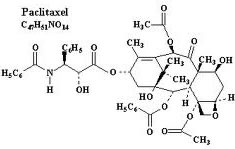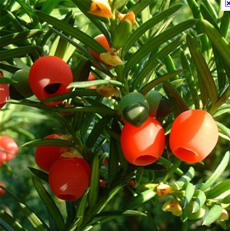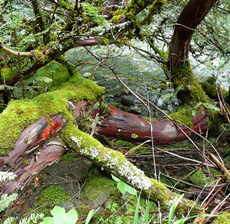Agriculture
 Also known by the brand name Taxol, paclitaxel is a potent cancer-fighting drug originally derived from the bark of the Pacific yew tree, a small- to medium-sized understory tree that occupies Pacific coastal forests from southwestern Alaska to California.
Also known by the brand name Taxol, paclitaxel is a potent cancer-fighting drug originally derived from the bark of the Pacific yew tree, a small- to medium-sized understory tree that occupies Pacific coastal forests from southwestern Alaska to California.
Development of paclitaxel as a drug began in 1962 with the collection in Washington State of the reddish-purple bark of the Pacific yew tree (Taxus brevifolia nutt) by Kurt Blum, then a technician with the National Cancer Institute (NCI). The NCI was employing a ?shotgun? approach to cancer research: A wide variety of plant parts of various species were being screened for anticancer activity.
Thereafter, several scientists, including Monroe Wall and M. C. Wani at Research Triangle Institute in North Carolina and Susan Horwitz and Peter Schiff of the Albert Einstein College of Medicine in New York, recognized the potential of paclitaxel and became intensely interested.
After years of delay, the pharmaceutical company Bristol-Myers Squibb continued tests and production on a larger scale. Paclitaxel was found to arrest the growth of cancer cells by attaching to their micro tubules, thus preventing cell division.
 By the late 1980?s Taxol had become the drug of choice, despite its high cost, for the treatment of a wide range of cancers, especially ovarian and breast cancer.
By the late 1980?s Taxol had become the drug of choice, despite its high cost, for the treatment of a wide range of cancers, especially ovarian and breast cancer.
In spite of Taxol?s prominence as a success story in the ?herbal renaissance? of the twentieth century, several problems involved in production and medicinal use have persisted. For one, the cost of Taxol treatment has been prohibitive for many who desperately need it.
The large amount of bark required (all the bark from a one-century-old tree yields only enough paclitaxel for a 300-milligram dose) raised fears among conservationists that continued harvest could threaten the species. While occurring over a wide area, the Pacific yew tree exists only in relatively small numbers.
Furthermore, it is a slow-growing species that rarely reaches a height of more than 18 meters (60 feet); stripping the bark kills the tree. Plantations of the Pacific yew tree could be established, but it would take years for them to become productive.
Several means of producing paclitaxel without the destruction of wild yew trees have been proposed. Attempts have been made to produce paclitaxel from tissue cultures.
 Efforts to identify other Taxus species that may contain paclitaxel have been only marginally successful. In 1993 Bristol-Myers Squibb announced that it had found a semisynthetic method of producing paclitaxel that does not require yew bark.
Efforts to identify other Taxus species that may contain paclitaxel have been only marginally successful. In 1993 Bristol-Myers Squibb announced that it had found a semisynthetic method of producing paclitaxel that does not require yew bark.
Paclitaxel-like compounds have been found in extracts from needles of the European yew tree (Taxus baccata) and those of several yew shrub species. An important advantage is that needles can be harvested without killing the trees or shrubs. Similar compounds have also been found in a fungus that grows on Taxus species.
- Medicinal Plants
Medicinal PlantsBecause plants are so biochemically diverse, they produce thousands of substances commonly referred to as secondary metabolites. Many of these secondary metabolites have medicinal properties that have proven to be beneficial to humankind....
- Metabolites: Primary Vs Secondary
Metabolites: Primary vs SecondaryMetabolites are compounds synthesized by plants for both essential functions, such as growth and development (primary metabolites), and specific functions, such as pollinator attraction or defense against herbivory (secondary...
- Can Graviola Cure Cancer?
Graviola is a substance that comes from a tree in the rain forests of Africa, South America, and Southeast Asia. Its scientific name is Annona muricata. It is also known as custard apple, cherimoya, guanabana, soursop and brazilian paw paw. In many countries,...
- The Amazing Health Benefits Of Turmeric
The active ingredient in turmeric is curcumin. Tumeric has been used for over 2500 years in India, where it was most likely first used as a dye. Aside from the holistic health community, Western medical practitioners have only recently come on board in...
- Rubber - Nature , Cultivation And Scope
Rubber tree - Nature Many plant species produce natural rubber. Quality and economics of the talks, however, one species, namely limited sources of natural rubber to Hevea brasiliensis.It is native to Amazon basin and tropical Asia and Africa countries...
Agriculture
Paclitaxel

Development of paclitaxel as a drug began in 1962 with the collection in Washington State of the reddish-purple bark of the Pacific yew tree (Taxus brevifolia nutt) by Kurt Blum, then a technician with the National Cancer Institute (NCI). The NCI was employing a ?shotgun? approach to cancer research: A wide variety of plant parts of various species were being screened for anticancer activity.
Thereafter, several scientists, including Monroe Wall and M. C. Wani at Research Triangle Institute in North Carolina and Susan Horwitz and Peter Schiff of the Albert Einstein College of Medicine in New York, recognized the potential of paclitaxel and became intensely interested.
After years of delay, the pharmaceutical company Bristol-Myers Squibb continued tests and production on a larger scale. Paclitaxel was found to arrest the growth of cancer cells by attaching to their micro tubules, thus preventing cell division.

In spite of Taxol?s prominence as a success story in the ?herbal renaissance? of the twentieth century, several problems involved in production and medicinal use have persisted. For one, the cost of Taxol treatment has been prohibitive for many who desperately need it.
The large amount of bark required (all the bark from a one-century-old tree yields only enough paclitaxel for a 300-milligram dose) raised fears among conservationists that continued harvest could threaten the species. While occurring over a wide area, the Pacific yew tree exists only in relatively small numbers.
Furthermore, it is a slow-growing species that rarely reaches a height of more than 18 meters (60 feet); stripping the bark kills the tree. Plantations of the Pacific yew tree could be established, but it would take years for them to become productive.
Several means of producing paclitaxel without the destruction of wild yew trees have been proposed. Attempts have been made to produce paclitaxel from tissue cultures.

Paclitaxel-like compounds have been found in extracts from needles of the European yew tree (Taxus baccata) and those of several yew shrub species. An important advantage is that needles can be harvested without killing the trees or shrubs. Similar compounds have also been found in a fungus that grows on Taxus species.
- Medicinal Plants
Medicinal PlantsBecause plants are so biochemically diverse, they produce thousands of substances commonly referred to as secondary metabolites. Many of these secondary metabolites have medicinal properties that have proven to be beneficial to humankind....
- Metabolites: Primary Vs Secondary
Metabolites: Primary vs SecondaryMetabolites are compounds synthesized by plants for both essential functions, such as growth and development (primary metabolites), and specific functions, such as pollinator attraction or defense against herbivory (secondary...
- Can Graviola Cure Cancer?
Graviola is a substance that comes from a tree in the rain forests of Africa, South America, and Southeast Asia. Its scientific name is Annona muricata. It is also known as custard apple, cherimoya, guanabana, soursop and brazilian paw paw. In many countries,...
- The Amazing Health Benefits Of Turmeric
The active ingredient in turmeric is curcumin. Tumeric has been used for over 2500 years in India, where it was most likely first used as a dye. Aside from the holistic health community, Western medical practitioners have only recently come on board in...
- Rubber - Nature , Cultivation And Scope
Rubber tree - Nature Many plant species produce natural rubber. Quality and economics of the talks, however, one species, namely limited sources of natural rubber to Hevea brasiliensis.It is native to Amazon basin and tropical Asia and Africa countries...
